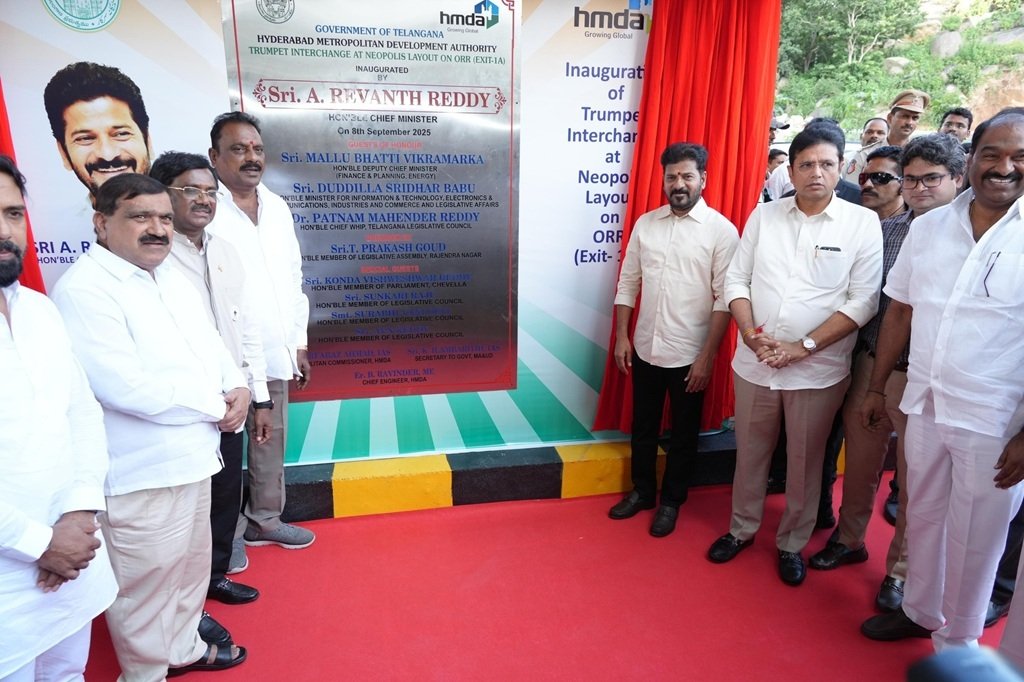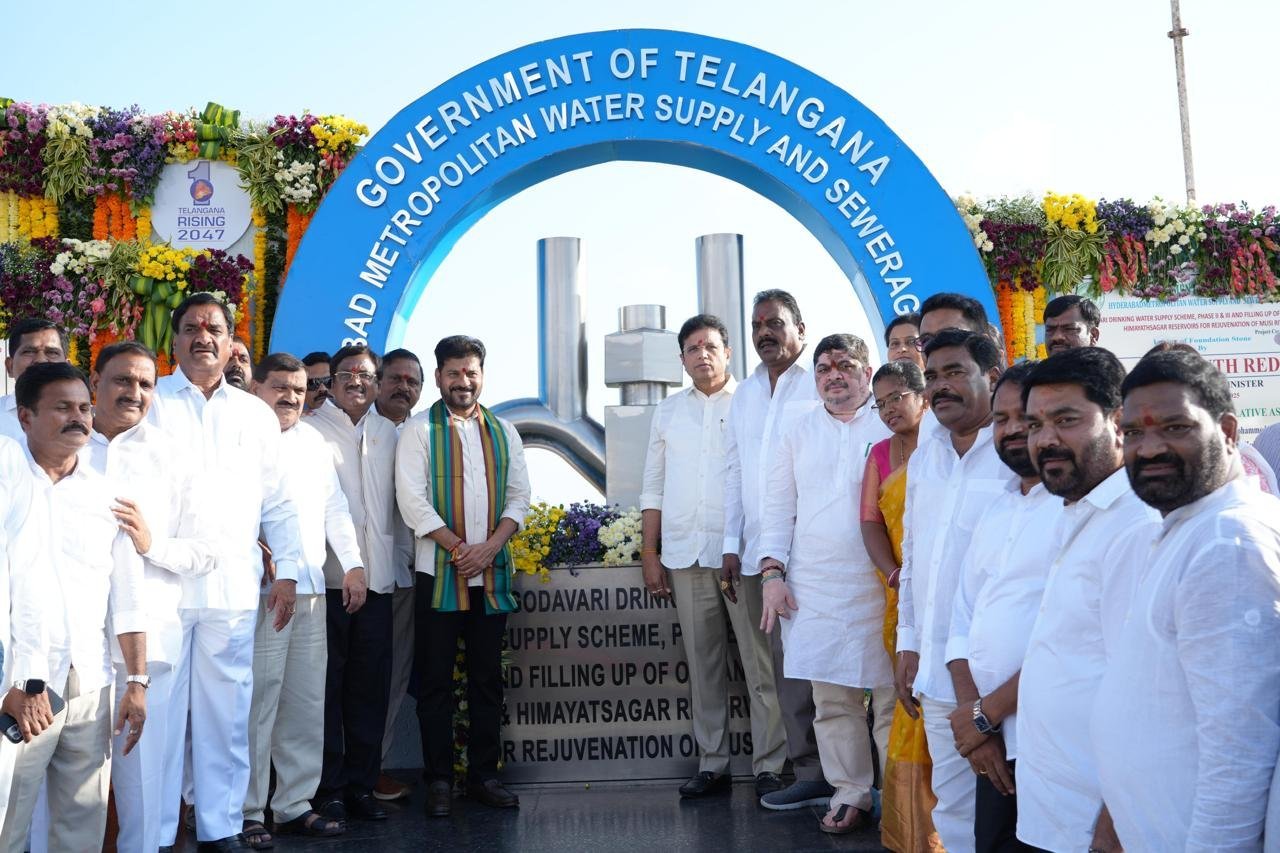Pipelines of the future: 100-year water plan
How do you future-proof a city that grows by the day, attracts lakhs of migrants every year, and aspires to become a true global hub? For Chief Minister A. Revanth Reddy, the answer lies in one word: water. Because if there’s one resource that defines the health, economy, and liveability of a city, it’s the availability of clean, reliable drinking water.
On September 8, 2025, Revanth Reddy laid the foundation stone for the Godavari Drinking Water Supply Scheme Phases II and III – a Rs. 7,360 crore project designed not just to meet Hyderabad’s immediate water needs, but to secure the city’s thirst for the next 100 years. That’s not political rhetoric. That’s planning anchored in hard projections, best infrastructure, and a vision that stretches beyond electoral cycles.
Why does Hyderabad need this leap?
Today, Hyderabad draws about 580 to 600 million gallons per day (MGD) from all sources. But by 2027, the demand is expected to touch 835 MGD, and by 2047, a staggering 1,114 MGD. That’s almost double the current supply. Without intervention, the city would have been staring at chronic shortages, water rationing, and annual summer agitations at the Secretariat – something older Hyderabadis still remember vividly.
So, Revanth’s government isn’t waiting for a crisis. Instead, it is anticipating the city’s growth curve and creating a water pipeline that matches its aspirations as a global city.
20 TMC of Godavari for Hyderabad
The Godavari Phases II and III will lift 20 tmc ft (thousand million cubic feet) of water from the Sripada Yellampally reservoir (often confused with Mallannasagar, but Revanth has clarified the source). Of this, 17.5 TMC will quench Hyderabad’s drinking water needs, while 2.5 TMC will rejuvenate the Musi River by filling the historic Osmansagar and Himayatsagar reservoirs and other intermediate lakes.
This is how an urban renewal plan at its best looks like. A cleaner Musi means better ecology, improved quality of life for people downstream in Nalgonda and beyond, and a riverfront that can become a cultural and economic asset. Revanth himself asked a pointed question: “If Sabarmati can be revived in Gujarat, and the Ganga and Yamuna cleaned in U.P. and Delhi, why should Musi be left out?”
Beyond Godavari: A comprehensive urban strategy
Unlike politically expedient freebies, this mega project follows a Hybrid Annuity Model (HAM) – the government funds 40% upfront, while private contractors mobilise 60% and get reimbursed over 15 years. This ensures accountability, faster timelines, and reduced financial strain on the State Exchequer. Completion is targeted for 2027. So, yes, Revanth Reddy is betting big, but not recklessly.

The Godavari scheme isn’t a standalone effort. On the same day, Revanth also inaugurated:
- ORR Phase-II Water Supply Project (Rs. 1,200 crore): 71 reservoirs, of which 15 are already complete, designed to serve 25 lakh people across 14 mandals including Saroornagar, Shamshabad, Medchal, and Rajendranagar.
- Kokapet Layout Integrated Development Project (Rs. 298 crore): Drinking water and sewage systems for Kokapet, Neopolis, and SEZ areas, benefitting 13 lakh residents in Hyderabad’s fastest-growing economic hub.
This is what sets Revanth apart. With his focus on the specifics of Hyderabad’s growth story – water for households, sanitation for new IT corridors, and infrastructure for suburbs and peri-urban communities, he proved himself as “a visionary leader who plans with foresight, anticipates and prepares for the future with confidence”.
A legacy of foresight, and what comes next
Revanth often reminds people that Hyderabad’s water history is built on foresight:
- The Nizam’s construction of Osmansagar and Himayatsagar after the 1908 Musi floods, which safeguarded the city for a century.
- The Congress government brought Manjeera water in 1965.
- Krishna water in 2002 through three phases.
- Godavari Phase-I in the 2000s.
Now, with Phases II and III, Revanth is adding the next chapter to that legacy. His simple pitch is what is winning hearts – while others played politics with projects like Pranahita-Chevella and Kaleshwaram, he is ensuring “Godavari water flows into every home in Hyderabad”.
A perfect fusion of Naidu’s IT push, YSR’s welfare policies
Hyderabad’s transformation owes much to two visionary leaders of the past. N. Chandrababu Naidu put the city on the global IT map in the 1990s, establishing HITEC City, attracting giants like Microsoft, and laying the foundation for Genome Valley. His “Hello Hyderabad” slogan symbolised the city’s shift from a regional capital to a global tech hub.
Dr. Y.S. Rajasekhara Reddy, meanwhile, balanced urban growth with agrarian revival. Through ‘Jalayagnam’, he launched one of India’s most ambitious irrigation programmes, aimed at irrigating over 7 million acres, providing drinking water to lakhs, and uplifting drought-prone Telangana. His policies like free power to farmers addressed rural distress while meeting the water needs of a fast-growing Hyderabad.
Now, Revanth Reddy is being seen as a fusion of both legacies. His government is pushing mega water projects for Hyderabad, cracking down on lake encroachments through HYDRAA, while simultaneously wooing investments in IT, pharma, and manufacturing. Alongside, his farmer-friendly initiatives aim to revive the rural economy.
By bringing together Naidu’s urban-tech vision with YSR’s welfare-driven development, Revanth is seen as the leader who can shape Hyderabad’s future while addressing Telangana’s agrarian roots.
Visionary leadership, not stopgap fixes
What makes this initiative stand out is not the scale of investment, but the time frame. Politicians usually think in five-year terms. Revanth is planning for 50 to 100 years, making sure that Hyderabad remains a water-secure metropolis even as its population increases and industries expand.
By doing so, he’s also reshaping the narrative for urban areas: from short-term sops to long-term infrastructure vision. That’s leadership which focuses on building cities, not winning elections alone.
Hyderabad Rising
Hyderabad has always been a city of ambition – from Charminar to Cyber Towers, it has reinvented itself across centuries. But no city can thrive without water. With the Godavari projects, Revanth Reddy is not only quenching today’s thirst but ensuring that tomorrow’s Hyderabad – twice as big – will have enough water to drink.
In politics, promises are often forgotten after the applause fades. But in this case, the pipelines, reservoirs, and rivers will stand as enduring proof of a leader who looked a century ahead.

